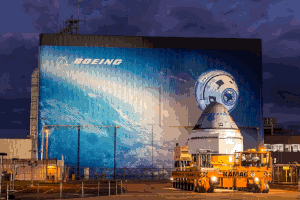Boeing strikes again. Crew capsule program tacks on another delay

Plagued with problems is putting it kindly…
Seven years after beginning the process of manufacturing the Starliner at KSC and almost fifteen laps around the center orb since its announcement, Boeing has dropped yet one more shard in the socket of the commercial crew program. It turns out that some of the parachute chord they tossed in the machine has weaknesses that could be catastrophic. There’s also a small matter regarding protective tape that covers wiring harnesses. Unfortunately, it appears that it’s fairly flammable. The current proposed solution is to simply cover said combustible material with a different type of wrapping shield and carry on.
NASA, of course, chimed in with overtly shiny public support because… what else can they do at this point. The agency is jammed into a corner by the need to have a second source for the program, and they’re too far down the path with Boeing to shift lanes at this juncture. The other organization chosen to supply essential machines and missions has already launched 10 flights with their Falcon and Dragon tubes since they lifted their equivalent productions into the sky, and the resulting contrast between the two teams and approaches cannot be more glaring.
“Our ultimate goal is to have one SpaceX and one Boeing flight per year rotate up to the station.”
The program manager for the CCP has strong experience leading teams and developing strategies but, at this point, even he has to be reaching the point where this goal has become inane at best. Why would that be?
Boeing clearly is having serious misgivings about not only the future of the project but, most importantly, taking it on at all. Amusingly, the VP for the Starliner program put forth this fine bon mot when asked if the company had given thought to pulling the plug on their participation – “No, not serious discussions about that.”
Translation – they’ve had extensive chats about it at all levels. Would they actually do so, however? I would venture that this is fairly unlikely due to the fact that the agreement they signed with NASA is heavily weighted towards the front end meaning that Boeing will be responsible for a large slew of costs and debits directly related to the now uncountable number of delays.
In order to achieve certification for the program they will have to inject a fair amount of their own cash and, in the process, most likely break even at best to reach this minimum goal. They could certainly drop out of the program, but this would undoubtedly kill future opportunities in relevant space activities. They also would most likely have to send back a good chunk of change to The Agency which would seem to be a non-starter on its face given Boeing’s current proclivity for squeezing any and all bits of ore from the heap no matter what grade it may be.
Back to Boeing basics
Fair enough. All of this points to the somewhat muddled and by no means certain prompt that Boeing will have to divert a good amount of resources to the program – something that has been counterintuitive to their culture for about the past 20 years. However, this shift in corporate approach has allowed them to become superb practitioners in the art of retroactively funding projects that proved to be massive miscalculations. The shotgun outsourcing of the 787 and the exceptionally misguided approach to building the 737 Max have certainly provided plenty of experience here. Add in the recent loss of a 500+ aircraft deal to Airbus, further delays on the T-7 program, and various other questionable steps in an array of initiatives and the cynically clear option here will be for them to make up cash deficiencies on the back end of the cost-plus SLS tablet.
The primary question then becomes a matter of determining what the future of this program may be even if it actually gets off the ground. Boeing clearly has little to no commitment to its future despite public proclamations, and the plethora of companies that are emerging and actually getting things done will further erode the position of an organization that truly could and should do much better.


